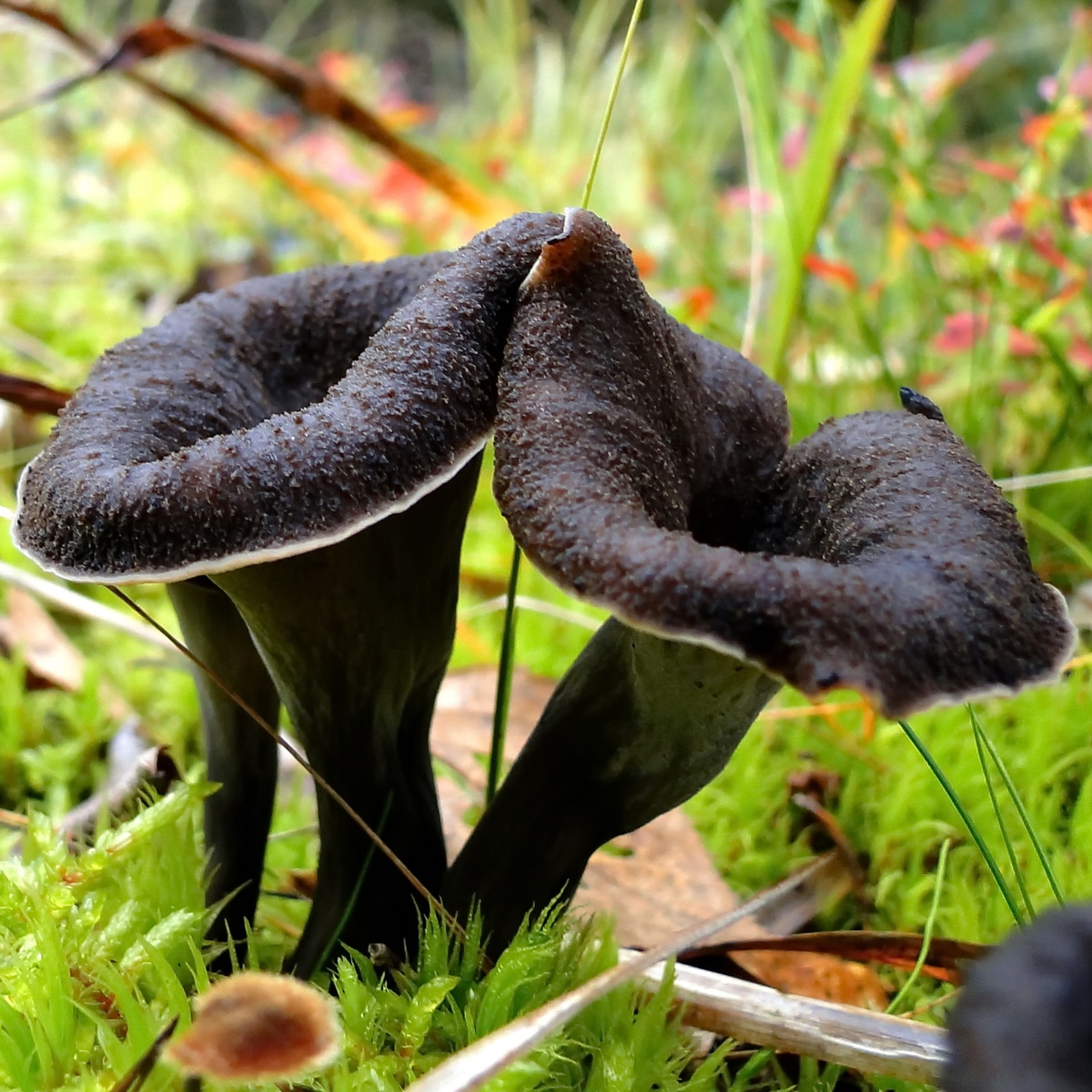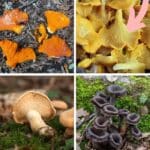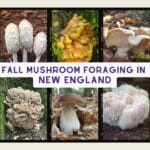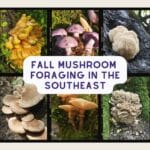The summer months are hot and buggy and often muggy, but there are a lot of prime edible mushroom species in the woods for anyone looking. Summer mushroom foraging in New England can be extremely fruitful. The summers might be super dry or extremely rainy – it varies each year, and you can expect the abundance of mushrooms to vary as well. Rainy summers bring more mushrooms! And more bugs, unfortunately!
Summer mushroom foraging in New England includes some top edible species, like chanterelles, chicken of the woods, black trumpets, and shaggy manes. Many other species fruit as well, inedible ones, so it’s important to know how to identify the edible ones.
Make sure you’ve got some good bug and tick spray when you’re out foraging. We love these permethrin-treated socks (and other clothing)—they really work to keep the ticks away. Also, we don’t go in the woods without these mosquito head nets to protect our faces from the relentless mosquitos and black flies. They may look a little funny, but they’re totally worth it!
If this guide is missing any New England summer mushrooms, please let me know in the comments. Also, don’t miss the other New England foraging guides: Spring Mushroom Foraging in New England, Fall Mushroom Foraging in New England, and Winter Mushroom Foraging in New England.

Jump to:
Summer Mushroom Foraging In New England
Chanterelles
The golden child of the mushroom world, chanterelles shine in the forest. Chanterelles can start showing up as early as late June, and fruit usually through August. As mentioned previously, a lot depends on the rain and humidity. Chanterelles like humidity – if it’s a dry year, you won’t find much of them.
Not all chanterelles are yellow; there are actually red and white varieties, as well as ones with smooth undersides — no false gills at all. Brush up on your chanterelle identification skills before hitting the woods so you don’t mistakenly pass any of these gems up.
The great thing about chanterelles is that there is rarely just one. They fruit in large scattered groupings; if you find a good spot, there could be pounds of them. Chanterelles also fruit from the same location every year, so mark your spots!
Summer Chanterelles – New England
- Cantharellus appalachiensis – Brownish-yellow cap, yellow false gills, and fruits with oaks and other hardwoods. This species is less common in New England than others, but it does show up.
- Cantharellus enelensis – This is another yellow-brown chanterelle with orange to yellow false gills. It fruits in conifer forests and is hard to differentiate from other species without DNA analysis.
- Cantharellus lateritius – Commonly known as the smooth chanterelle, this species has a smooth to slightly wrinkled underside instead of defined false gills. Its cap and underside are both golden yellow-orange, like the classic chanterelle. This species grows primarily with oak trees but will also fruit with hickories. It is more common in the lower midwestern states and either uncommon or underreported in the upper Midwest.
- Cantharellus minor – As the scientific name suggests, this chanterelle species is small compared to the others. It rarely gets more than 1.5 inches tall and has an orange-yellow cap and false gills. It fruits around oaks and other hardwood trees.
- Cantharellus cinnabarinus – This is the Northeast’s red chanterelle. The cap is bright orange, red, or flamingo pink. It is a small chanterelle, growing only up to 1.5 inches tall. It grows with oaks, beech, big-toothed aspen, and shagbark hickory.
If you want to learn more about all the different chanterelle species, check out our guide: Red, White, and Golden Chanterelles of the US: Identification Guide.

Black Trumpets
The black trumpet mushroom usually starts showing up in mid-to-late summer, but sometimes it’s earlier. Most people consider it a late summer to fall mushroom, but in recent years, it’s been showing up earlier. Black trumpets are top in the edible mushroom world because of their unique smoky and earthy flavor.
Black trumpets can be hard to find – those grayish-to-blackish funnels blend right in with the forest leaf litter. Foraging black trumpets takes lots of patience, searching, and often many miles logged. Once you find them, though, mark that spot. They return every year, and the patches in a good rainy year are prolific and outstanding.
These special edible mushrooms add a rich, deep flavor to soups, stir-fries, omelets, and risottos and also make an excellent gourmet salt. They’re super fragile and have a short shelf life, so transport them carefully and use them quickly.

Chicken of the Woods
If you’re fortunate enough to come across chicken of the woods, it’s an excellent day of foraging! Chicken of the woods is one of the absolute best wild mushrooms, and it’s a great species for new foragers because there are no lookalikes. In New England, chicken of the woods fruits primarily in late summer and fall, but it will also show up in spring or just about anytime it feels like it. This species doesn’t like to be pigeonholed!!
The bright orange and yellow shelves of chicken of the woods are hard to miss, especially when they cover an entire tree or log. The mushroom returns yearly, so be sure to note the location and date you found it so you can catch it in future years.
The texture and succulance of chicken of the woods make it an excellent replacement for poultry chicken. You can fry it up, add it to stews, grill, barbeque, or stir-fry it.
In New England, there are actually a few species of chicken of the woods. And not all of them are the quintessential bright orange and yellow.
- Laetiporus sulphureus – This is the classic bright orange and yellow chicken of the woods with yellow spores. It grows in dense clusters on hardwoods. It is most common on oak trees but will also fruit from poplar, willows, beech, locust, cherry, and pear.
- Laetiporus cincinnatus – While this chicken of the woods may look like it’s growing from the ground, it is actually growing from buried wood. This confuses many people as it can often be found 5-6 feet away from a tree, but rest assured, it is attached to the tree roots beneath the soil. Because it is usually growing from buried wood, it also forms a bit differently from other chicken of the woods. Instead of stacked overlapping shelves, this species grows as a rosette. In addition, it also is peachy orange instead of bright orange or yellow and has white spores. This one really sets itself apart from the other chickens of the woods! You can find it growing around oak trees.
- Laetiporus huroniensis – This chicken of the woods looks just like the classic L.sulphureus, except it grows on conifers instead of hardwoods. It has bright orange or yellow caps and yellow pores.

Yellow Oyster Mushrooms
Most oyster mushrooms prefer the cooler weather of spring and late fall, but yellow oyster mushrooms are their own beast. They are not native to North America; they’re escapees from cultivation and, therefore, should be foraged with abandon! They aren’t precisely invasive – they aren’t causing any known harm (yet), but they aren’t native, so forage all that you see.
Yellow oyster mushrooms aren’t super common in New England, but their range is spreading, and it wouldn’t be strange to see them. If you find yellow oysters, please record the find on iNaturalist or Mushroom Observer so their spread can be tracked. This map from Mushroom Observer of their occurrence is fascinating – they seem to be following I87 up the Hudson River.
Yellow oysters, like gray oysters, are top edible mushrooms and delicious. They’re versatile in recipes and great in everything from stir-fries to soups to pizzas and, of course, fried. They have a light mushroomy taste that easily takes on other flavors without losing its own.

Yellowfoot Chanterelles
The yellowfoot is a close relative to chanterelles and it’s very noticeable. These little chanterelle-looking mushrooms are bright orange to brownish and grow from the ground all summer long. Yellowfoot mushrooms grow in abundance in the Northeast and are decent edibles. They don’t taste nearly as good as their cousins; in fact, they’re rather bland. But they are widely foraged because they appear in such vast fruitings and are so common.
The size and stem are key to differentiating the yellowfoot mushroom from a chanterelle. Yellowfeet are small, like the the smallest chanterelle species, and they have a hollow stem. Chanterelles don’t have hollow stems.
This forager commonly finds yellowfoot chanterelles fruiting in the same area, if not at the same time and place, as black trumpets (another chanterelle relative). So, whenever you see yellowfeet, check around for black trumpets. Black trumpets usually fruit just a little bit later (but not always), so make sure to check back a few times throughout the season to see if the trumpets show up in the same vicinity.

Shaggy Mane
The shaggy mane is a widely foraged edible species with an incredibly short shelf life. If you find these, be prepared to cook them up within hours of foraging them. Left for too long, they turn into puddles of inky goo. Shaggy manes tend to show up later in the summer in New England, depending on the weather.
These mushrooms show up in meadows, grasslands, along paths, and on the side of the road — they like disturbed areas. And usually they fruit in massive groupings, so there are at least a few that are still prime for foraging. Remember, if they have even the beginning of decomposition (deliquescence), they’re not worth gathering. You want them all white and solid.
Shaggy manes have a mild mushroomy flavor that is great in simple recipes where the mushroom can be the star. A simple saute or adding them to pasta is a good choice. Or, making them the star in a wild mushroom soup.

Lobsters
Possibly one of the most bizarre edible mushroom species, the lobster mushroom is actually the result of another fungi species being parasitized by this one. This wild transformation creates the highly sought-after wild lobster mushroom. Lobster mushrooms are thick, dense, and have a slightly sweet flavor.
Some people say they taste like ocean lobster, but that is a trick of the mind based on visual similarity. They are delicious, but they don’t taste like seafood. They sure look like it, though!
Lobster mushrooms fruit throughout the summer and are usually pretty easy to spot due to their brilliant red or orange coloring. However, they do like to hide in the thick forest duff, so be on the lookout and check out those mushhumps! A mushhump is a bump in the forest leaf debris, indicating a mushroom is under the duff, slowly pushing its way out. The great thing about this species is that it tends to reoccur in the same place every year, so if you find them, be sure to mark the spot.

Hedgehogs
The adorable toothed hedgehog mushroom is sweet and nutty-tasting, with dense flesh. It is also pretty easy to identify due to its unique teeth under the cap, where most mushrooms have gills. Hedgehogs are usually considered a late summer to fall mushroom, but they will start showing up in mid-summer most years.
Many people miss out on foraging hedgehogs because, from above, they’re rather plain-looking and easily overlooked. The tan to buff-white cap of the hedgehog mushroom is lumpy, undecorated, and often blends in with the surroundings. This is why we stop to inspect every mushroom, even if it looks boring from above.
Hedgehog mushrooms are a treat in the kitchen. Cooking brings out their sweet nuttiness, and they are excellent in stir-fries, sauteed with butter and garlic, or added to soups and stews.

Puffballs
Puffballs, big and small, start showing up in mid to late summer. Finding a giant puffball is a treat, but the smaller puffballs are also edible. You just have to forage a lot more to get a meal. Puffball mushrooms are among the easiest to forage because they look distinct. However, you do have to be careful with the small puffballs because there are dangerous lookalikes that resemble them when they’re babies.
Giant puffballs, on the other hand, are one of a kind. Nothing else looks like someone left their volleyball sitting in the middle of a field! A foraged puffball will feed you for days. And, a lot of the time, there is more than one fruiting in an area, so you might end up with several of these monsters at once.
They’re not the best-tasting mushrooms, rather bland and airy in texture and flavor. But they take on other flavors really well and can be used much like tofu. They also dehydrate really well and can be used to bulk up soups and stews.

Tips For Summer Mushroom Foraging In New England
- If it’s a rainy summer, don’t wait too long after the rains to go out foraging. The slugs and bugs will be racing you for any mushroom, and the excess rain will make the fungi deteriorate quicker. It’s not uncommon to find a lot of literally mushy mushrooms when there’s a lot of rain.
- In dry summers, the slugs aren’t as bad, but there aren’t as many mushrooms fruiting, so you have to be more patient and possibly do a lot more hiking.
- Remember your bug and tick spray! Seriously, the tick situation is awful and shouldn’t be disregarded – it’s not a matter of if you will get ticks on you, but how many. But if you take the proper precautions and always do tick checks after being in the woods, you should be fine.
Other Summer Mushrooms In New England
You’ll probably stumble across lots of russula and milky cap species. These two look pretty similar, and both have edible varieties in them. They’re not included in this list because most of them, even if edible, aren’t that fantastic. Some are decent, but not compared to the prime edible species listed above.
A lot of boletes are also starting to show up in the forest. Make sure you read up on the boletes before foraging them. They can be tricky, though thankfully, not super dangerous; they just taste really bad if you get the wrong ones.










Leave a Reply